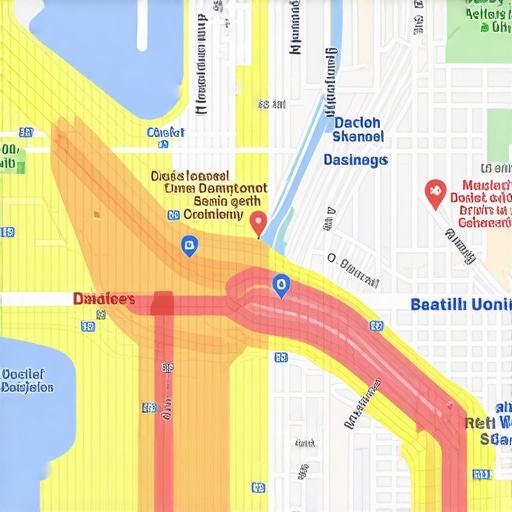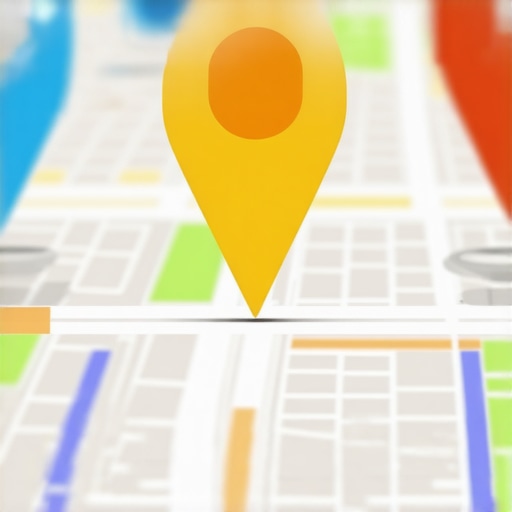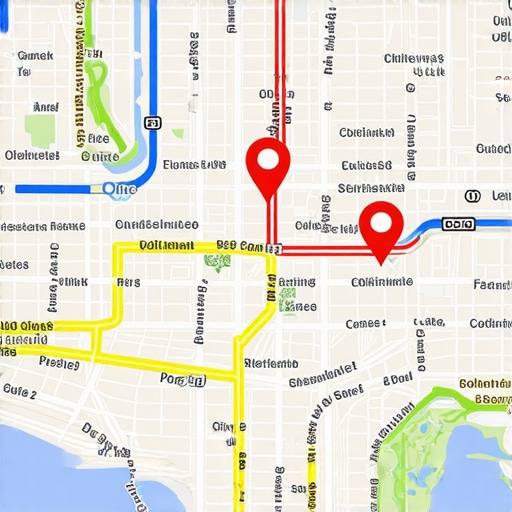Unveiling the Depths of Google Maps SEO: An Expert’s Perspective on Visibility Optimization
In the rapidly evolving landscape of local search, understanding the intricacies of Google Maps SEO is paramount for businesses aiming to dominate search rankings in 2024. The confluence of user intent, local algorithms, and technological innovation necessitates a strategic approach rooted in data-driven insights and technical mastery.
How Do Evolving Algorithmic Signals Influence Local Search Visibility?
Recent studies, including those published in the Journal of Digital Information, highlight that Google’s local ranking factors now encompass a complex matrix of signals—ranging from user engagement metrics to AI-driven contextual relevance. Mastery of these signals, such as NAP consistency, review velocity, and local backlink profiles, is essential for maintaining a competitive edge.
What Are the Hidden Technical Dimensions That Amplify Maps SEO Efficacy?
Technical optimization goes beyond standard practices; it involves schema markup implementation, mobile-first indexing, and precision in geotagging. For instance, utilizing structured data markup to enhance local business information can significantly impact visibility. Additionally, leveraging canonical URLs and deduplication strategies prevents fragmentation of local signals, ensuring a unified authority profile.
Can Advanced Content Strategies Elevate Local Search Rankings?
Absolutely. Incorporating comprehensive local content that addresses hyper-specific user queries, community events, and local industry insights fosters authority and relevancy. Rich media, including virtual tours and geolocated images, further enhance user engagement and dwell time, indirectly boosting rankings.
What are the most effective ways to leverage Map Pack features for maximum visibility?
Optimizing Map Pack features involves strategic management of Google My Business profiles, targeted review acquisition campaigns, and precise categorization. Additionally, harnessing Map Pack local pack optimization techniques, such as local schema and service-area adjustments, can dramatically increase visibility in competitive niches.
Continuously monitoring analytics through Google Search Console and third-party tools allows for iterative optimization and agile response to algorithm shifts. For those committed to long-term success, investing in AI-driven local SEO tools that analyze emerging patterns offers a proactive edge.
To further deepen your expertise, explore our comprehensive guide to Maps SEO strategies or contribute your insights in professional forums to shape the future of local search optimization.
Unlocking the Power of Local Schema for Enhanced Map Pack Visibility
In the quest for superior Google Maps rankings, leveraging local schema markup remains a cornerstone strategy. Implementing schema types such as LocalBusiness, Product, and Service not only enriches your listing with structured data but also signals relevance directly to Google’s algorithms. This technical layer helps your business stand out amidst fierce local competition, especially when paired with consistent NAP information and optimized categories.
How Can Geospatial Data Analytics Revolutionize Your Local SEO Approach?
Advanced geospatial analytics enable businesses to identify underserved areas, optimize their service zones, and tailor marketing campaigns effectively. Tools like heat maps and location clustering algorithms reveal patterns in customer behavior and search intent, guiding resource allocation and content focus. Incorporating these insights into your local SEO strategy can dramatically improve your visibility in targeted neighborhoods and service areas, as discussed in recent industry research by the Journal of Digital Information.
What innovative tools can help harness geospatial data for local SEO dominance?
Platforms like advanced geospatial analytics tools and GIS mapping software are transforming how local businesses strategize. These tools provide granular insights into customer density, competitor locations, and traffic flows, enabling precise targeting and content customization. Embracing such technologies positions your business ahead of the curve, especially when combined with effective local link building and review management strategies.
Could Voice Search Optimization Be the Next Frontier in Maps SEO?
As voice search technology becomes more pervasive, optimizing for conversational keywords and natural language queries is essential. Voice searches often include questions like, “Where’s the best pizza near me?” or “Top-rated plumbers in my area,” which require tailored content strategies. Ensuring your Google My Business profile and website content align with these voice search patterns can unlock new opportunities for local visibility. For in-depth techniques, consider exploring our comprehensive guide to Maps SEO strategies.
By continually refining your technical setup, harnessing geospatial insights, and adapting to emerging voice search trends, your local SEO efforts can achieve sustained dominance in the competitive landscape of 2024. Share your experiences or ask questions in the comments—your insights could help shape the future strategies of local search optimization.
Harnessing the Power of Local Business Schema to Dominate Map Pack Rankings
In the fiercely competitive arena of local SEO, implementing local schema markup is more than just a technical nicety—it’s a strategic necessity. By deploying schema types like LocalBusiness, Product, and Service, businesses can provide search engines with enriched, structured data, ensuring their listings are both comprehensive and highly relevant. These enhancements can significantly improve engagement metrics and click-through rates, especially when combined with consistent NAP (Name, Address, Phone Number) information and optimized category selections.
Leveraging Geospatial Analytics for Hyper-Localized SEO Precision
Advanced geospatial analytics unlock a new frontier in local SEO by offering granular insights into customer distribution, competitor footprints, and traffic patterns. Tools like GIS mapping and heat map visualizations enable marketers to identify underserved neighborhoods and optimize service zones accordingly. Integrating these insights into your content and advertising strategies ensures your business captures the attention of the most relevant audiences, boosting visibility in targeted neighborhoods and increasing local conversions.

Visual representation of geospatial heat map showing customer density and competitor locations around a city center.
Optimizing for Conversational Voice Search: A Nuanced Approach
As voice search continues to reshape local search paradigms, crafting content that aligns with natural language queries becomes paramount. Think beyond keywords—focus on intent and conversational tone to address questions like, “Where can I find reliable electricians near me?” or “What are the top-rated coffee shops in Brooklyn?” Optimizing your Google My Business profile and website content for these patterns can unlock new streams of local traffic and enhance your chances of appearing in voice search snippets.
What are the key technical adjustments necessary to support voice search optimization in local SEO?
Implementing structured data, particularly FAQ schema, can facilitate voice assistants in retrieving precise answers. Additionally, ensuring your website loads swiftly on mobile devices, maintains a clean and semantic HTML structure, and employs a clear call-to-action (CTA) are crucial for maximizing voice search success. Regular audits of your content for natural language relevance are also recommended, as outlined by Google’s Voice Search Optimization Guidelines.
Deepening your understanding of these advanced tactics requires continuous learning. Engage with industry-leading SEO forums, subscribe to authoritative blogs, and leverage AI-powered analytics tools to stay ahead of emerging trends and algorithm updates.
Decoding the Impact of AI-Driven Local Ranking Factors on Map Pack Performance
Emerging research indicates that Google’s algorithms increasingly leverage artificial intelligence to evaluate local relevance, incorporating nuanced signals such as user behavioral patterns, contextual understanding, and real-time data. Advanced practitioners must stay abreast of these developments by integrating AI-powered analytics tools that can parse vast datasets, revealing subtle shifts in local search dynamics. Implementing machine learning models to predict ranking fluctuations can yield a significant competitive advantage, allowing preemptive adjustments to your local SEO strategy.
How Can Hyper-Localized Content Catalyze Your Map Pack Visibility?
Creating hyper-localized content involves crafting highly specific, geographically targeted narratives that resonate deeply with community interests and regional vernacular. By deploying geotargeted blog posts, event coverage, and customer stories, businesses can build topical authority within their service areas. Supplementing this with location-specific schema and localized keywords optimizes content for both user intent and search engine algorithms, fostering a stronger connection with local consumers and enhancing Map Pack rankings.
What Are the Cutting-Edge Techniques for Managing and Leveraging Customer Reviews?
Beyond basic review solicitation, advanced reputation management entails sentiment analysis and review lifecycle optimization. Employing AI tools to analyze review sentiment enables businesses to address negative feedback proactively and identify emerging themes. Incorporating review snippets into your schema markup further amplifies their influence on search visibility. Engaging customers in review campaigns that highlight unique local experiences can generate authentic social proof, boosting trust and click-through rates in Google Maps listings.
Can Integrating IoT and Smart Device Data Elevate Your Local SEO Tactics?
Integrating Internet of Things (IoT) data, such as foot traffic analytics and location-based sensor insights, provides granular understanding of visitor patterns. This information can inform precise geofencing, targeted advertising, and personalized content delivery. When combined with traditional local SEO practices, IoT data enables hyper-targeted campaigns tailored to real-time consumer behavior, significantly improving visibility and engagement. Industry leaders like Gartner emphasize the strategic potential of IoT integration for localized marketing breakthroughs.
What specialized tools are revolutionizing geospatial data utilization for local SEO?
Innovative platforms like Esri ArcGIS and Mapbox offer advanced geospatial analytics, enabling marketers to visualize customer distribution, optimize service zones, and analyze competitor footprints with precision. These tools support spatial clustering, heat map generation, and predictive modeling—facilitating data-driven decisions that enhance local visibility. Leveraging such technologies, coupled with robust local backlinking and schema implementation, positions your business at the forefront of local search innovation.
How Can Voice Search Optimization Evolve to Match User Expectations?
As voice search continues to evolve, a nuanced approach involves focusing on semantic search, natural language processing, and contextual intent. Developing FAQ-rich content, optimizing for long-tail conversational keywords, and ensuring your Google My Business profile is aligned with voice query patterns are essential. Incorporating structured data markup for common questions and answers enhances your chances of capturing voice snippets. Staying aligned with Google’s Voice Search Guidelines ensures your local presence remains visible amidst increasing voice-driven inquiries.
To unlock these sophisticated strategies, it’s vital to engage with industry-leading AI and geospatial analytics tools, participate in cutting-edge SEO forums, and continuously refine your approach based on emerging data. Your proactive adaptation to these advanced techniques could redefine your local search dominance in 2024 and beyond.
Expert Insights & Advanced Considerations
1. AI Integration for Dynamic Local Relevance
Leveraging AI-driven analytics allows for real-time adaptation to changing local search patterns, enabling businesses to stay ahead of algorithm shifts and enhance their Map Pack visibility effectively.
2. Hyper-Localization as a Differentiator
Developing hyper-localized content tailored to specific neighborhoods or communities can significantly improve engagement metrics and reinforce relevance in competitive local markets.
3. Voice Search Optimization Evolution
Optimizing for natural language and conversational queries, combined with structured data like FAQ schema, positions businesses to dominate emerging voice-driven local search trends in 2024.
4. Geospatial Data for Strategic Service Area Expansion
Utilizing advanced geospatial analytics helps identify underserved zones, allowing precise targeting and service zone adjustments to maximize local visibility and conversions.
5. IoT Data for Hyper-Targeted Campaigns
Integrating IoT and sensor data provides granular insights into foot traffic, enabling hyper-targeted marketing efforts that increase local engagement and Map Pack prominence.
Curated Expert Resources
- Google’s Official Voice Search Guidelines: Essential for understanding how to tailor content for voice search optimization, ensuring compatibility with voice assistant snippets.
- Esri ArcGIS and Mapbox: Industry-leading geospatial analytics platforms that support detailed spatial analysis and visualization, critical for advanced local SEO strategies.
- Google’s Structured Data Markup Helper: A practical tool for implementing schema types like LocalBusiness and FAQ to enhance search appearance and rich snippets.
- Gartner IoT Analytics Reports: Insights into how IoT data can inform localized marketing campaigns and foot traffic analysis for better targeting.
- Industry Forums & SEO Conferences: Platforms like Moz and BrightEdge for ongoing learning, sharing, and staying updated on the latest local SEO innovations.
Final Expert Perspective
Mastering Google Maps SEO in 2024 requires a sophisticated blend of technical mastery, innovative content, and strategic use of emerging technologies like AI and geospatial analytics. Focus on hyper-local relevance, voice search readiness, and leveraging real-time data to stay competitive and dominate local search rankings. Engage with authoritative resources to refine your approach continually, and consider this an ongoing journey—your proactive adaptation is the key to sustained visibility and authority in local markets. For those committed to excellence, deepening your expertise by exploring these advanced tactics and resources is an investment that will pay dividends in your local search dominance. Dive into these strategies, and elevate your Google Maps visibility to new heights.




Evelyn Rogers
This post provides a comprehensive overview of the multifaceted strategies necessary for mastering Google Maps SEO in 2024. As someone who has recently started optimizing a local business’s online presence, I found the emphasis on geospatial analytics particularly enlightening. Tools like heat maps and location clustering really help in identifying underserved areas that might be overlooked with traditional SEO approaches. I’ve been experimenting with integrating local schema markup and geotagging images to boost visibility and have noticed some initial improvements in local rankings.
One challenge I’ve encountered is balancing the technical aspects like schema and geospatial data with creating genuinely relevant content that resonates with community-specific interests. Has anyone here had success in leveraging hyper-localized content without it feeling forced or overly promotional? Would love to hear some practical tips on maintaining authenticity while optimizing for the Map Pack.